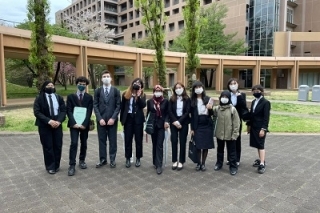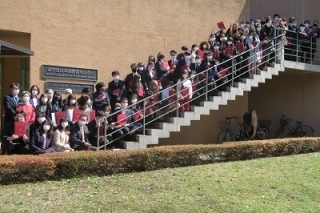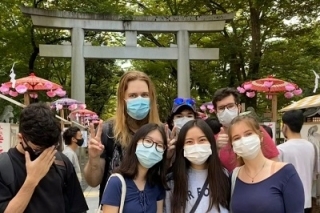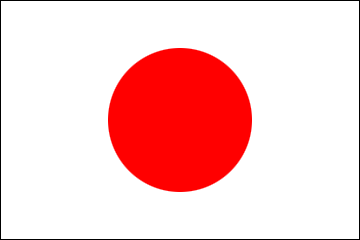Japanese Government (MEXT) Undergraduate Scholarships
2021/8/24
 The eight students (myself second from left) entering TUFS this year from the preparatory course, with some new friends made on induction day.
The eight students (myself second from left) entering TUFS this year from the preparatory course, with some new friends made on induction day.
 The 60-odd students and teachers gathered together on graduation day, celebrating our successful completion of the course.
The 60-odd students and teachers gathered together on graduation day, celebrating our successful completion of the course.
 A photo taken in autumn 2020 of a small trip to Ōkunitama Jinja (大國魂神社) to see a festival.
A photo taken in autumn 2020 of a small trip to Ōkunitama Jinja (大國魂神社) to see a festival.
MEXT Alumni Personal Experiences
Russ Ryuichi Houghton
Japanese Government (MEXT) Undergraduate Scholarship
Preparatory Education at Tokyo University of Foreign Studies 2020-2021
Bachelor student at Faculty of International and Area Studies, Tokyo University of Foreign Studies 2021 - present
I was fresh out of sixth form, in the middle of a shift at work during my gap year when I received the email confirming my place on the scholarship programme. To say I was exhilarated would be an understatement! The months-long process had come to a fruitful end.I had applied for deferred entry to university, with the hope of being able to volunteer in the Olympics, and while looking at the volunteer options began to consider a period of study in Japan. I attended the 2017 Experience Japan Exhibition, wherein various Japanese universities encouraged students to attend, among which was a stand for the MEXT scholarship, beginning the journey that led me to where I currently am now: Tokyo.
Having completed the relevant paperwork, wrangling a medical check-up that ticked all the required boxes, the day came for the exam-and-interview day at the Japanese Embassy. Thanks to the past papers provided by JASSO, I had some idea of what to expect, most importantly that I would have to learn some American English maths terms (apparently orthogonal means diagonal). However, I had little idea of what to expect for the interview, conducted partly in English and partly in Japanese. Despite it being a much more pleasant experience than I feared, the nerves were definitely there!
Then coronavirus struck. Had the borders closed a fortnight later, I would have been able to take my visa and fly to Japan, but alas I along with all the other students across the world were suddenly held in limbo. Around mid-May, online classes began in limited capacity as there was only a small window of time in which everyone could take part in lessons together due to time zones, for example I remember very clearly having to choose between a 2.30AM or 6.30AM lesson. Then in August, as Japan’s cases were very low, came at first a rumour of special entry permission then an email informing us of the time and date of a flight. The amount of notice varied: I got a week’s notice, but the Argentinian only got 36 hours! My family went into quarantine mode as I had to get a negative PCR test in order to fly, so unfortunately visiting family and friends to say goodbye was out of the question. Thankfully we live in the internet age, so staying in touch has been very easy.
Having arrived, I completed my preparatory education at the Japanese Language Centre in TUFS, along with all other humanities students. According to some senpai, this was the first year that humanities and sciences had been completely split into two locations, science students receiving their preparation at Osaka. We had intensive language classes for 3 hours every morning, split into 3 levels of proficiency, followed by afternoon classes in culture, politics, and history, with either maths or geography, depending on your chosen field. Intensive is definitely the word to describe the course, but completely manageable thanks to the supportive teachers and camaraderie amongst students. Despite the variety in ages, bonds quickly developed and I am certain many of the friendships I made will last.
The university selection process mirrored UCAS very closely, it was all oddly familiar. I was to choose five universities, ranked in order of preference, write a personal statement, and based on my December test results would be allocated a place. I managed to enter my second choice university, the very same campus where I was taking the preparatory course: TUFS. Among other things, this allowed me to continue being a part of the badminton club which had allowed me to take part during my preparatory course.
The first term at TUFS is the second spring with coronavirus, and a robust system of online and socially distanced classes has developed. My larger lectures (30+ students) are held exclusively on Zoom, while most of my smaller classes are held in person. All online classes require students to submit a short report on their thoughts about the topic, so there is no room for sleeping with the camera off! Most lectures are held in Japanese, although there are a growing number held in English, as TUFS has a strong short-course programme for international students.
As of the time of writing, I have finished (and passed) my exams and end-of-term reports and have properly started the summer holidays. There are two Olympic venues nearby, for badminton and cycling, so the 2020 livery and coaches full of lanyard-wearing people are all over the place. It is a little difficult not being able to easily fly home to see everyone or travel widely in Japan, but the sights here in Tokyo and occasional calls with friends and family are keeping me busy enough. I was also given the opportunity to speak to students in my secondary school on a panel discussing study abroad options at university; to anyone reading this currently thinking about going for a short or long term study abroad, I thoroughly recommend it!


